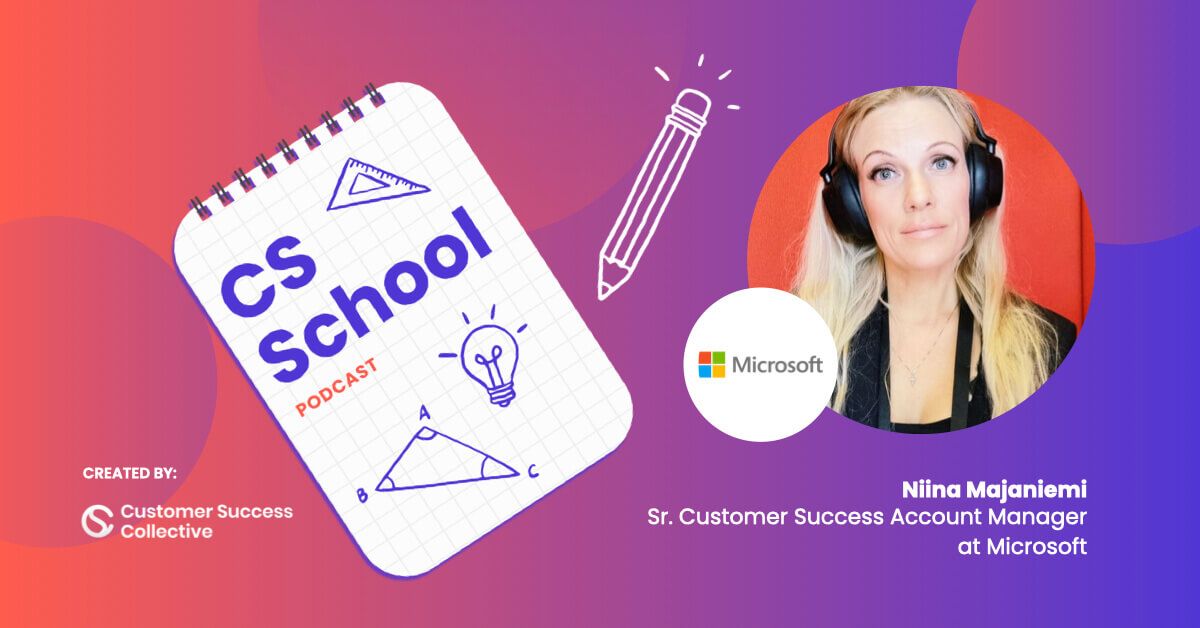When it comes to cultivating leadership skills in customer success, it’s about sculpting a framework of continual growth, understanding, and empowerment in every interaction with our teams and customers.
Throughout my career I've honed my skills across various aspects of customer success, giving me profound insights into the essence of leadership in a customer-centric industry.
In this article, I’ll unpack the top 10 customer success skills essential for future leaders, emphasizing how these competencies not only drive immediate customer satisfaction but also build a lasting impact that resonates well beyond initial engagements.
If you’re in a rush, here are my top 10 skills integral for anyone venturing into leadership:
- Integrity
- Empathy
- Empowerment
- Communication
- The role of "amplifier"
- Accountability
- Engaged listening
- Decision making
- Visionary
- Set high standards
Embracing leadership
When it comes to leadership, I find Simon Sinek's insights incredibly potent. He once said:
“A leader's job is not to do the work for others, it's to help others figure out how to do it themselves, to get things done, and to succeed beyond what they thought possible.”
As we explore these top skills, some may sound familiar, perhaps they are even skills you are currently developing. However, I urge you to view them as an opportunity to reflect on how these practices can be actively integrated into your daily work.
This isn’t just about becoming a better customer success professional; it’s about evolving into a stronger leader, and a more effective communicator, and challenging yourself to grow beyond your current boundaries.
Top 10 skills for future customer success leaders
1. Integrity
The first and arguably most crucial skill is integrity.
This might seem like an obvious starting point and a fundamental aspect of any professional relationship, yet it is indispensable. Building trust is the bedrock of all our interactions, and it begins with being honest and genuine.
If customers sense any insincerity or feel that we are attempting to deceive them, it will immediately erode their trust in both us and our company.
While there may be occasions when we need to present ourselves optimally or be selective about the details we divulge, honesty cannot be compromised. These strategies might buy time temporarily, but transparency is essential for long-term trust.
We must share our knowledge and the real situations we face with our customers. This is not just about avoiding immediate pitfalls; it’s about cultivating a relationship where customers believe in what we say and feel respected.
Treating others with fairness and respect may also seem like a basic expectation, yet it is one of the most vital qualities in customer success. Starting with this fundamental principle is essential because it sets the tone for everything we do and every relationship we build.

2. Empathy
Many of us in this industry, when asked about the most vital attribute we seek in new hires, will point to empathy. While some individuals naturally possess higher emotional intelligence, empathy is a skill that can be cultivated and refined, which I strongly advocate for, especially for CSMs.
Oprah Winfrey once beautifully articulated that:
"Leadership is about empathy. It’s about having the ability to relate to and connect with people for the purpose of inspiring and empowering their lives."
For a CSM, this translates into understanding the customer's perspective and genuinely seeing the situation through their eyes.
It involves more than just managing a support ticket or a service level agreement; it's about comprehending the customer’s frustrations and the impact of issues on their business operations and success with your solutions.
Effective empathy in our role means not only ensuring customers feel heard but also conveying their needs and situations internally to ensure we advocate for them effectively. This approach starts by being fully present in the moment, not rushing through interactions to move on to the next task. It requires patience to truly grasp what the customer needs, beyond simply providing an answer or performing a task.
Empathy involves being mindful of how responses, whether verbal or written, can affect customers. If you notice a colleague's communication might be perceived as off-putting, it's crucial to help recalibrate the tone or clarify the intent. This proactive approach ensures that we maintain a focus not only on conveying information but also on shaping the customer's overall experience with empathy and understanding.

3. Empowerment
Empowerment is a cornerstone of effective leadership, and John Maxwell, a renowned leadership expert, encapsulates this perfectly:
"Leaders become great, not because of their power, but because of their ability to empower others."
This principle is incredibly relevant as you grow into leadership roles and begin to oversee team members directly. However, its application extends beyond formal authority, especially in customer success.
In our field, direct control is often limited. We collaborate extensively across the organization —engaging with support, product management, and professional services among others. One of your most impactful roles is to facilitate these interactions and strengthen your position within these dynamics. This approach not only supports internal team empowerment but also extends to how we empower our customers.
Consider a scenario where a customer asks for a report they could generate themselves using your solution. While it might be quicker to simply send the report initially, true empowerment involves teaching and guiding them on how to access and interpret this information on their own. This not only helps them understand the value of your solutions better but also encourages deeper engagement with the tools provided.
Empowering customers to be more self-sufficient not only reduces your workload in fulfilling repetitive requests but also enhances their experience with your product. As customers become more adept at using your solutions, they become more reliant on them, thereby increasing customer stickiness and efficiency.
To effectively empower both your team and customers, focus on providing the right training, guidance, and resources. This enables them to succeed independently, fostering a more sustainable and satisfying interaction with your services.

4. Communication
Communication is fundamentally integral to everything we do in Customer Success. It is the primary tool through which we connect with others, enhance relationships, and build trust. To help you excel in this critical area, I want to share some practical tips to refine your communication skills.
Clarity
Always start with clear, specific references. For instance, mention the exact functionality being discussed, acknowledge the specific query from the customer or confirm their needs clearly. This approach eliminates ambiguity and ensures that everyone is on the same page from the beginning.
Be concise
In your communications, whether verbal or written, being concise is vital. Use intentional language that gets to the point quickly. This is particularly important in written communications that may need to be forwarded or shared. Conciseness also makes it easier for the customer to remember the key points and facilitates deeper, more focused discussions.
Context, medium, and audience
Always consider the context in which you are communicating, the medium you are using, and who your audience is. In her book on digital body language, Erica Dhawan discusses how these elements are crucial, especially in a time where remote work prevails and we have fewer in-person interactions with customers. Understanding digital communication nuances can greatly enhance how we convey and interpret messages.
As we adapt to less frequent face-to-face interactions, such as those in quarterly business review meetings, we must become even more adept at using digital tools to gauge and respond to our customers' needs effectively.
This involves not only choosing the right words but also being mindful of the overall digital presence and how it impacts our communications.
By focusing on these aspects of communication, you can significantly improve how you engage with and serve your customers, leading to better relationships and more successful outcomes.
%20(1).jpg)
5. The role of "amplifier"
One of the less conventional, yet profoundly impactful ways to view the role of a CSM is as an amplifier. Just as an amplifier boosts the signal of whatever feeds into it, a successful CSM amplifies the voice of the customer within the organization. This role involves not only increasing the visibility and influence of customer feedback but also magnifying the effectiveness of every team interaction.
To become an effective amplifier, consider these strategies:
- Enhance customer impact: Think proactively about what will affect your customer’s performance in the future. By understanding and anticipating their needs, you can contribute significantly to their success. This might involve recognizing potential challenges before they become issues or identifying opportunities for your customer to leverage your solutions more effectively.
- Utilize internal resources: Look for unique talents within your team that can be brought to the forefront. For example, involving an operations person who usually works behind the scenes in a customer meeting can add depth to the discussion. They might possess detailed knowledge that can provide valuable insights to the customer, thereby enhancing the customer’s perception of your company’s expertise.
- Increase team visibility: By bringing diverse team members into customer interactions, you not only develop their skills and exposure but also reinforce the depth of your organization’s expertise to the customer. This approach ensures that you are not seen as the sole point of contact but as part of a robust team capable of addressing a wide range of needs.

6. Accountability
Accountability is a pivotal aspect of leadership and professional development, embodying an internal commitment to take ownership, accept responsibility, and diligently follow through on promises made to oneself and others. This concept is central to the role of a CSM, as it underpins our ability to handle challenges and maintain integrity in our interactions.
At its core, accountability means having the courage to face challenges head-on, to question leadership when necessary, and to take responsibility without casting blame. Maya Grossman’s book, which I highly recommend, offers deep insights into fostering accountability within professional roles. It stresses the importance of graceful acceptance and responsibility for mistakes, rather than deflecting fault onto others.
As a CSM, there are situations where the responsibility for an issue might seem to lie equally with the customer, or even predominantly on their side.
However, taking a moment to assess your own or your company's contributions to the issue can shift the dynamic from one of blame to one of cooperation and solution-finding. When starting with self-accountability, you set the stage for constructive dialogue and quicker resolution.
An important aspect of accountability is adopting an internal locus of control. This concept involves understanding how your actions influence outcomes, rather than attributing external factors as the primary drivers of success or failure. By focusing on your influence over situations, you not only improve current scenarios but also enhance your ability to positively affect future outcomes.
Incorporating these principles of accountability into your daily work as a CSM not only upholds standards of integrity and honesty but also equips you to navigate and improve challenging situations more effectively.

7. Engaged listening
Engaged listening is a fundamental component of effective communication, and it deserves special attention. While many of us pride ourselves on being good listeners, it's worth reflecting on how we listen.
Truly engaged listening involves more than just hearing words; it's about understanding both what is said and what remains unsaid. It requires the ability to pick up on nonverbal cues, which can be challenging in remote interactions but not impossible. We must be attentive enough to sense if a customer might be holding back on crucial feedback or concerns.
One effective method to enhance understanding is by asking open-ended questions that encourage customers to share more about their experiences. This approach not only shows that you are genuinely interested in their perspective but also provides them with the space to express themselves more fully.
Even if you think you know the answer early in a conversation, resist the urge to respond immediately. Take the time to listen thoroughly and allow the customer to outline all their points. This not only helps in understanding their current situation better but also builds a stronger rapport.
If you sense reluctance or detect a touchy subject, don’t shy away. Ask thoughtful questions that might encourage customers to open up about disappointments or unmet needs. This can be daunting, especially if you suspect that their needs might exceed the capabilities of your solution, but the insights gained are invaluable.
Every piece of feedback, whether positive or negative, is a gift. It offers a unique opportunity to better understand the customer's needs and expectations, which can then be translated into actionable insights for product enhancements and improvements.
By focusing on engaged listening, asking better questions, and showing genuine interest in the customer's experience, we can foster stronger, more meaningful relationships. This not only enhances customer satisfaction but also drives continuous improvement within our organizations.

8. Decision making
Decision-making is a critical skill for any CS professional, at any stage of their career – but it’s exceptionally essential if you’re planning on becoming a leader. Our customers look to us for guidance and a clear plan of action. This skill involves processing information, understanding the impacts of different choices, and making informed recommendations.
Often, as CS professionals, we find ourselves coordinating between various internal teams like support consultants and product development. There might be times when the solution seems beyond our control or when we're waiting on crucial information to proceed. During such times, our role as decision-makers becomes even more significant.
Even when the perfect solution isn't clear, presenting options such as "we can either do A or B" can significantly aid in moving the discussion forward. This not only helps in internal decision-making but also shows the customer that progress is being made. Being proactive in proposing potential solutions or paths can reassure the customer that their issues are being addressed promptly and effectively.
The ability to provide timely and thorough responses is essential in maintaining customer trust and satisfaction. It shows that we are not only responsive but also diligent in seeking the best outcomes for their concerns.
Decision-making prowess often comes from experience, education, and input from others who have more expertise in specific areas. It's perfectly acceptable not to have all the answers immediately; what's important is the commitment to obtaining the necessary information to make informed decisions.
As CSMs, our aim should be to enhance our decision-making skills continuously. This not only involves making decisions ourselves but also empowering our customers and internal teams by providing them with the information and options they need to make their own informed decisions.
9. Visionary
Warren Bennis, a respected voice in leadership, once stated that:
"Leadership has the capacity to translate vision into reality."
This insight is particularly relevant for CSMs, as it highlights the importance of visionary thinking not only for top leaders but for everyone involved in customer engagement.
As a CSM, part of our role involves outlining long-term plans and strategies that resonate with our customers. This isn’t just about maintaining routine engagement; it's about setting a vision for how our solutions can lead to successful outcomes for the customers. Whether it's through mapping out an onboarding plan or understanding the broader customer journey, the ability to articulate this future clearly is crucial.
The true test of effective visionary thinking is in our ability to communicate the end goals and purposes in a way that not only makes sense to our customers but also inspires them to take action. When customers understand and are motivated by the vision set for their journey with our solutions, they are more likely to derive greater value from both the solution and their interactions with us.
By establishing and communicating a clear, strategic vision, we enable our customers to see the potential impacts and benefits of our solutions in their operations. This foresight helps in building a strong, value-driven relationship that goes beyond mere transactional interactions to becoming a partnership geared towards achieving their long-term success.
The role of a visionary in customer success is about more than just foreseeing future trends; it’s about creating a roadmap that guides the customer effectively towards achieving their objectives, thereby transforming the envisioned benefits into tangible results.

10. Set high standards
"Set high standards, and the universe will meet you there."
This phrase, though it may sound somewhat idealistic, captures the essence of striving for excellence in everything we do. It's not merely about doing your best work; it's about establishing a high bar for yourself, your team, and even your customers.
Starting by setting high expectations is fundamental. This involves not only expecting a lot from your team members in terms of performance and collaboration but also setting clear expectations with your customers.
By clarifying what you expect from them in terms of communication, collaboration, and input, you foster a mutual sense of accountability. This shared commitment to high standards enhances the value both parties derive from the relationship.
Another critical aspect of setting high standards is embracing the role of a lifelong learner. As you can see from my own experiences, much of my time is dedicated to reading, exploring new ideas, and continually challenging myself to grow. I encourage you to adopt the same mindset.
Continual learning and growth are not just about personal development; they also involve finding new ways to add value to our roles and responsibilities.
This learning-driven approach should also extend to reinventing and improving processes, not only within customer success but across the organization. Even if a process falls outside your direct purview, be proactive in suggesting improvements.
Sharing insights and innovative ideas can significantly enhance how teams function and how customers interact with your company.
By setting high standards and continuously pushing the boundaries of what is possible, we not only achieve greater personal and professional growth but also drive significant advancements in how we deliver value to our customers.
Embrace the challenge of high standards; it will not only set you apart as a leader but also significantly impact the success of your customers and your organization.
Final thoughts
Our role as CSMs is fundamentally about enriching the customer's experience and outcomes through our active engagement and presence. Every interaction is an opportunity to make a positive difference, to solve problems, and to guide our customers towards achieving their goals.
More importantly, the true measure of our effectiveness is the lasting impact we leave behind. It’s about ensuring that the improvements, solutions, and strategies we implement continue to benefit the customer long after our direct involvement has ended. This could mean setting up systems that enhance their operations, imparting knowledge that empowers them to solve future challenges independently, or influencing their strategic direction in a way that continues to yield benefits.
Consider how each skill and insight contributes not only to immediate solutions but also to building a foundation for sustained success. Whether it's through fostering accountability, practicing engaged listening, or being visionary in our approach, each aspect of our role is geared towards making a significant, enduring impact.

Have we opened up a curiosity door?
If Rebecca's article has stirred a hunger for more leadership knowledge, we have just the thing.
You can enroll in our Customer Success Leadership Accelerator program and become one of tomorrow's champions of customer success.
What to expect in this game-changer of a course:
🧠 Non-stop, actionable insights
🔧 Practical applications every week
🤫 Total privacy with your closed CS leadership group
👥 Tons of networking opportunities
📚 Hands-on coursework activities
💡 Endless ideas from your peers and presenters
🔥 Fuel to shape your gold-standard CS strategy



 Follow us on LinkedIn
Follow us on LinkedIn




